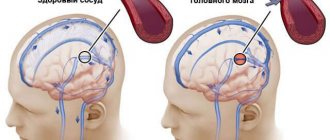Intracranial neoplasms of a benign or malignant nature are called brain tumors. They can affect not only tissues, but also nerves, blood vessels, membranes, and endocrine structures. Depending on the location of the lesion, different symptoms appear. To make a correct diagnosis, it is necessary to undergo an examination by a neurologist and an ophthalmologist, as well as undergo a number of tests, including MRI of the brain and MR angiography. For treatment, surgery is most often used, which is supplemented with radiation or radiotherapy.
Stages
Over the past year, more than 34 thousand cases of brain tumors have been identified in our country. Moreover, the disease is “getting younger.” Increasingly, pathology is diagnosed in young people, men and women who have not reached the “middle age” criterion. Brain tumors often develop in pregnant women during long periods of pregnancy. In this case, it is extremely difficult to provide quality treatment. In addition, the tumor grows very quickly.
The reason for this is in the symptoms. When a person complains of fatigue, depression and loss of concentration, he is advised to rest instead of being advised to get an MRI.
Depending on the nature of the tumor, the rate of development of the disease varies. Benign neoplasms develop more slowly, but are often practically asymptomatic in the early stages. Malignant ones are more aggressive and develop faster.
For benign ones, there are several stages of development:
- Initiation. The disease can only be detected at this stage by luck. At this moment, a DNA shift occurs in the brain cells, they change under the influence of certain factors.
- Promotion. At this moment, active reproduction of mutated brain cells occurs. However, the disease may not manifest itself even at this moment.
- Progression . The mutated cells begin active growth and the neoplasm fills the free intracranial space, compressing neighboring organs and tissues.
At the last stage, the tumor itself does not lead to serious symptoms, but compression of organs and tissues can lead to convulsions, disorientation, speech delays and other obvious symptoms.
At the last stage of development, the doctor can easily diagnose brain cancer without even using special equipment.
Malignant neoplasms are characterized by rapid division and growth of the tumor with possible metastases to various, even the most distant organs. The immune system does not have time to recognize the “enemy”, as a result of which the disease invades new organs and tissues, becoming inoperable and difficult to treat. This often happens in a short time.
There are several types of benign pathologies:
- Glioma. Characterized by frequent hemorrhages.
- Neuroma. Formed from elements of the nervous system. Symptoms of the disease include redness on the skin and pain in the area of the formed tumor.
- Neuroma. It is represented by numerous nodules in the spinal cord.
- Paraganglioma . A congenital form of a benign tumor. May provoke the appearance of metastases. Manifested by headaches, tachycardia and increased blood pressure.
- Cyst. A large cavity filled with fluid that can appear in various organs and tissues, including the brain. The danger of the pathology lies in its rapid growth.
- Meningioma. The most common form of benign tumor. However, it often turns into a malignant form and provokes the appearance of metastases. According to statistics, women suffer from the pathology more often than men; the disease develops especially quickly in women carrying a child.
- Schwannoma. It disrupts the functions of the middle ear and upsets the human vestibular apparatus. Symptoms include headache with nausea and vomiting, as well as complete or partial hearing loss.
- Craniopharyngioma. Characterized by slow tumor growth and the appearance of cysts. Symptoms include diabetes insipidus, dry skin, obesity, dwarfism or infertility.
- Pituitary adenoma. The tumor compresses the organs of the brain, most often in the area of the optic nerves. This leads to loss of peripheral vision, as well as a feeling of double vision. Men with this disease experience impotence, and women have menstrual irregularities and infertility.
There are fewer types of malignant tumors. They come down to the three most common types: gliomas, sarcomas and teratomas. Sarcoma is formed from connective tissue and is characterized by rapid growth and frequent relapses. Teratomas are formed from gonocytes, and gliomas are characterized by neuroectodermal origin.
A consultation with a doctor and a series of tests will help determine what type of tumor is located in the brain and its danger to the entire body. Although the intracranial space is so vulnerable and has numerous vessels, nerve endings and other organs, even a benign tumor will be quite dangerous to the patient’s health.
Symptoms of the disease
In the early stages, it is almost impossible to detect a brain tumor. The fact is that the main symptoms are very similar to other pathologies, which complicates diagnostic measures.
Most often observed:
- nausea, unlike poisoning or rotavirus disease, relief does not occur after the stomach is emptied;
- severe pain in the head, in an upright position, but without movement, the person feels relief, but the spasm worsens if he begins to move;
- epileptic seizures or convulsions;
- memory weakens and concentration decreases.
Such symptoms are rarely taken seriously, and in the meantime, it is much easier to cure a tumor in the head in the early stages of the disease. All of the listed symptoms will indicate the disease if they are present simultaneously in the patient. At the second stage, when the tumor grows and the meninges are excited, cerebral changes appear. These include:
- the sensitivity of the skin is lost in certain areas of the body;
- sudden dizziness accompanies the patient;
- muscle tissue weakens on one or both sides of the body;
- severe fatigue and drowsiness become a constant companion of a person;
- there is double vision in the eyes.
At this stage of a brain tumor, treatment may still be effective. However, therapeutic procedures are more difficult and longer than in the early stages of the pathology. At the same time, the risk of relapse increases significantly.
The symptoms of the second stage of a brain tumor are similar to several diseases - epilepsy, hypotension or neuropathy. Therefore, you should not panic and make terrible diagnoses in advance. It is necessary to visit a specialized doctor and undergo appropriate examinations. Any of the listed conditions requires doctor's supervision and timely treatment.
Important!
If you suspect something is wrong, contact your doctor immediately. Once the diagnosis is confirmed, you will be prescribed a course of chemotherapy. It is recommended to take the course in trusted clinics. They provide high-quality diagnostics and also use the latest treatment technologies.
Causes and risks of tumor appearance
The causes of primary brain tumors are quite difficult to establish and are not possible in all patients.
But doctors have identified some factors that may increase the risk of this disease, including:
- Exposure to radiation. People exposed to ionizing radiation (eg, radiation therapy for cancer, radiation from atomic bombs, etc.) have an increased risk of brain tumors.
- Family history of brain tumors. A small proportion of brain tumors occur in people who have a family history of brain tumors or genetic syndromes that increase the risk of developing a tumor.
- Age. Despite the fact that tumors can occur at any age, they still occur more often in children and the elderly.
- Floor. In general, men are more susceptible to this type of tumor than women. But some specific types of tumors, such as meningioma, are more common in women.
In addition, research is currently also being conducted on the relationship between the occurrence of tumors and the effects of such factors:
- chemicals (solvents, pesticides, petroleum products, etc.);
- infections, viruses, allergens;
- electromagnetic fields;
- head injuries and seizures;
- race and ethnicity.
In general, a risk factor is anything that increases the likelihood of developing a brain tumor. Knowing your risk factors can help you and your doctor detect the tumor early.
Signs of a Brain Tumor
Signs of a brain tumor may indicate a particular neoplasm, depending on its location and size. They can be identified in the early stages if you carefully take care of your health. More often observed:
- Numbness or loss of sensation in certain areas of the body.
- Hearing and vision loss, partial or complete.
- Confusion, significant memory impairment.
- Intelligence and self-awareness are greatly altered.
- The speech is confused.
- “Jumping” hormonal levels.
- Changes in mood in a person with a high switching speed.
- Aggressive states, increased irritability, hallucinations.
Vision problems indicate a tumor in the back of the brain, and spasms and numbness in the frontal lobes. To determine the location of the tumor and carry out quick, high-quality therapy, you need to visit a doctor and take the necessary tests. Instrumental studies and examinations on devices are also carried out to thoroughly diagnose the disease.
Diagnosis of the disease
When primary symptoms or signs of a brain tumor appear, a person needs to immediately see a neurologist and ophthalmologist. To collect anamnesis, echocardiography, EEG, and focal symptoms are examined.
A brain tumor, the symptoms of which are often focused on a person’s vision, requires consultation with a specialist. The ophthalmologist checks your visual acuity by performing standard examinations. Also determines visual fields and performs ophthalmoscopy procedures. This is important for understanding the size and impact of the tumor on the visual organs and other important body functions.
If necessary, an additional consultation with a specialist otoneurologist is scheduled.
If the doctor suspects a large tumor, you will have to undergo a CT or MRI of the brain. This can be done at the clinic medart.by. Such studies help to visualize the tumor and determine its boundaries, clear location and influence on other organs and systems.
In addition to standard procedures, the doctor can prescribe a number of special studies that help determine the malignancy of the tumor, analyze metabolic abnormalities, and distinguish between multifocal tumors. Sometimes it is necessary to do a biopsy of the tumor, which will provide accurate data about the nature of the tumor.
Among the main analyzes are:
- MRI of cerebral vessels;
- functional MRI;
- MR thermography;
- MR spectroscopy;
- PET scan of the brain;
- SPECT.
Tests and diagnostic studies are prescribed exclusively by the doctor after collecting an anamnesis. Going through these procedures on your own without justification and prior consultation is unacceptable. A person can go to the doctor on his own if he believes that his symptoms are similar to those of brain cancer, but he can only visit an MRI, ultrasound or other functional diagnostic rooms with a referral from a doctor.
Diagnosis is required when relatives already have cancer in the family, and the patient also has all the signs of early-stage brain cancer. It's a good idea to get regular checkups for people who have suffered a traumatic brain injury or stroke.
Reviews of doctors providing the service - Back and spine injuries
In 2000, Andrei Arkadyevich performed spinal surgery on me.
Four days in the clinic and I have been living a full life for 20 years without restrictions on movement and I remember with gratitude Dr. A.A. Khodnevich. God bless him. And in 2000 he could walk no more than 10 meters. Read full review Viktor Alexandrovich
20.05.2020
Low bow to Alexander Semenovich Bronstein and Andrei Arkadyevich Khodnevich. I arrived at CELT on July 2, 2021 with extreme pain that I endured for 10 days. Hernia C6-C-7. I was given two blockades in Ivanovo, about 9 complex IVs, I lost 6 kg in a week and was in a panic, I didn’t see a way out and nothing happened to me... Read full review
Elena Nikolaevna L.
20.10.2019
Forecasts
Brain cancer is characterized by cautious predictions by doctors. A positive outcome depends on the nature of the tumor, its location, size and ability to provoke the spread of metastases.
The easiest way to treat small tumors in a place accessible for surgical intervention, benign in nature and not metastasizing to other organs. Usually one course of radiation or chemotherapy is enough to rid a person of pathology.
However, most benign tumors tend to recur. In this case, repeated surgery will be required, which can lead to serious damage to the nervous system.
Malignant tumors develop rapidly and contribute to the spread of metastases. As a rule, the location is inconvenient for surgical intervention. Removing a brain tumor is impractical or even dangerous. In this case, the prognosis is in most cases unfavorable.
The age and general health of the patient are of great importance. In elderly citizens with severe concomitant pathologies, removal of the tumor through surgery is not available.
Treatment
The choice of treatment method directly depends on the nature of the disease, the location of the tumor, its size and type. The age and general condition of the patient are also taken into account. The main treatment methods include:
- Surgical intervention. Some tumors have a convenient localization and are easily separated from the tissues without damaging the surrounding organ. If the location is inconvenient, there is a brain tumor, surgery will not completely help. The surgeon cuts off part of the tumor to eliminate compression and significantly improve the patient’s quality of life.
- Radiosurgery. It refers to the types of radiation. As part of the procedure, the patient undergoes small doses of radiation from different directions, while the rays converge at the location of the tumor, destroying it. At the same time, the surrounding tissues remain unharmed.
- Radiation therapy. You can irradiate the tumor directly or the patient’s entire brain. The second option is used for relapses, when it is necessary to eliminate the risk of developing metastases in tissues.
- Chemotherapy. Drugs that have a systemic effect on the tumor and destroy it, preventing the development of metastases to organs. It helps fight symptoms, slow down the growth of tumors and reduce the risk of relapse.
- Targeted treatment. They have a targeted effect on tumor cells, killing them. Reproduction and growth are blocked. Causing cell death.
To regulate the patient's condition, constant monitoring is carried out using MRI. If the tumor does not shrink or continues to grow, the chosen method of therapy is not effective. Also, regular studies are carried out after victory over brain cancer to exclude recurrence of the pathology.
After treatment and victory over brain cancer, rehabilitation will be required. Most often, the tumor affects important functions that will have to be restored after quality therapy.
Typically, rehabilitation includes a number of important activities. For example, classes with a speech therapist to restore normal speech, individual lessons with a tutor, physical therapy and occupational therapy. It is also recommended to use appropriate medications to reduce the severity of symptoms and increase the effect of treatment, as well as eliminate side effects.
Procedures and operations
Brain cancer is a serious disease and tumor removal is important to perform accurately, so a neuronavigation system is used during the operation. Before surgery, the patient’s research data is entered into the navigation system program, and a 3D computer model of the brain with tumors and blood vessels is obtained, which helps virtually plan the operation. Surgical treatment is based on the principle: extracerebral tumors are removed completely, and intracerebral tumors are removed as much as possible, so that brain function does not suffer. Any operation should involve minimal trauma, preservation of brain structures, blood vessels and veins. Some areas of the brain are considered inoperable - these are the motor and speech areas.
Minimally invasive surgery to remove a tumor is performed using laser, stereotactic and endoscopic techniques. Minimally invasive operations are performed through endonasal access (through the nostril), supraorbital (through an incision above the eyebrows), retrosigmoid (incision behind the ear), as well as through any point convenient for removing deep-lying tumors. Minimally invasive approaches are as effective as invasive ones. If the operation is performed on functionally significant areas, then laser technologies are used. This could be laser thermal destruction. For deep-lying tumors, brachytherapy and photodynamic therapy are used to destroy them.
Highly effective technologies allow treatment without surgery. These include radiosurgery methods: linear accelerator, gamma knife. However, they can be used for small lesions.
Gamma Knife is a form of radiation therapy. This ultra-precise method destroys even several formations per session. The method is applicable for multiple lesions (tumors of metastatic origin). The CyberKnife system is equipment based on a linear accelerator that delivers high doses to the tumor and destroys it. The operation does not require open intervention. If the tumor is large, the bulk of the tumor is first surgically removed, and then irradiation with the CyberKnife system is used.
Boron-neutron capture therapy method. With this method of exposure, the destruction of a tumor that has accumulated the boron-10 isotope is carried out by neutron irradiation. Boron accumulated in cells increases sensitivity to radiation. Boron isotopes absorb neutrons and a “nuclear” reaction occurs, during which energy is released that destroys the new formation. Brachytherapy has not become widespread. It is carried out by implanting radioactive sources (iridium-192, iodine-125, palladium-103) into the tumor tissue.
Before the operation, the possibility of its implementation and safety are taken into account. Without these predictions, surgical treatment is considered inappropriate. With any type of intervention, consequences are possible in the form of disturbances in movement, speech, hearing, vision, reading, and mental changes. It all depends on the location of the tumor and the degree of trauma to surrounding tissues. When a pituitary tumor is removed, hormonal function is disrupted. Motor disturbances that occur immediately after surgery are associated with cerebral edema. But with the use of decongestants, patients recover quickly.
Prevention
Preventive measures to get rid of brain cancer include a number of measures that are aimed at eliminating the recurrence or growth of tumors in the brain.
First of all, it is necessary to exclude oncogenic effects and head injuries. They can provoke the development of tumors or cause a relapse of already cured pathologies. The patient is advised to spend more time in the fresh air, to choose a place of residence away from industrial plants and other objects hazardous to health.
Be sure to check your health regularly so that, if necessary, you can identify a cancerous tumor at an early stage of brain cancer. It is also recommended to avoid taking biogenic drugs that can provoke the growth of tumors in the brain.
Brain cancer is a dangerous pathology, most often characterized by unfavorable prognosis, since any surgical intervention in the brain can provoke serious changes in consciousness and body function. It is much easier and more effective to treat a brain tumor in the early stages of development. However, diagnosing the disease during this period is extremely difficult.
List of sources
- Dzeranova L.K., Pigarova E.A., Petrova D.V. Space-occupying formations of the hypothalamic region and disorders of the central regulation of homeostasis/ Obesity and metabolism. - 2014. - No. 3. From 45-50.
- Balkanov A.S. Malignant glioma of the brain: age-related features, new approaches to diagnosis and treatment: Abstract of thesis. dis. ...Dr. med. Sciences / A.S. Balkanov. – Moscow, 2010. – P. 145. 2.
- Matsko D. E. Classification of tumors of the central nervous system (WHO) / D. E. Matsko, M. V. Matsko // Russian Neurosurgical Journal named after. prof. A. L. Polenova. – 2021. – T. VIII, No. 4. – P. 5-11.
- Trashkov A.P., Spirin A.L., Tsygan N.V. Glial tumors of the brain: general principles of diagnosis and treatment/Pediatrician. - 2015. - No. 5. - P. 8-10.
- Belsky K.K. Incidence of malignant gliomas of the brain in the Volgograd region. /Russian journal of oncology. - 2010. - No. 4. - P. 39-42.









